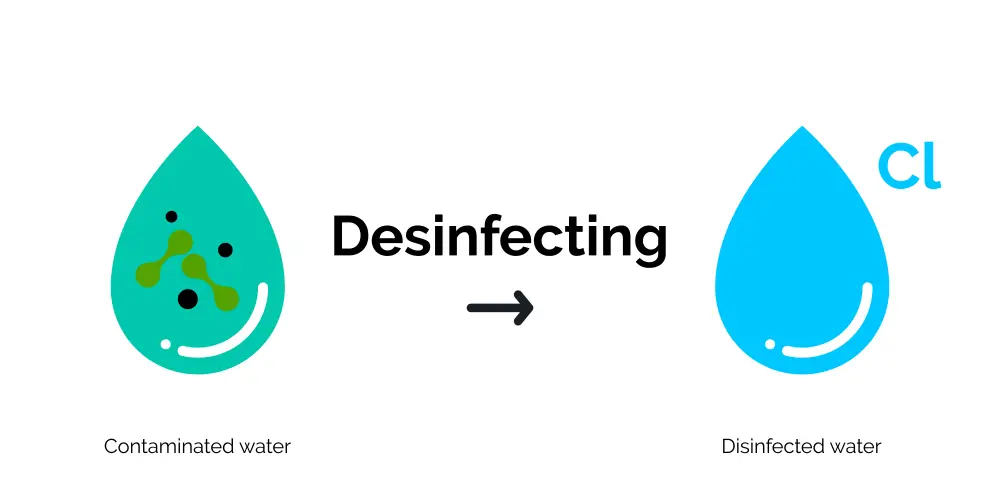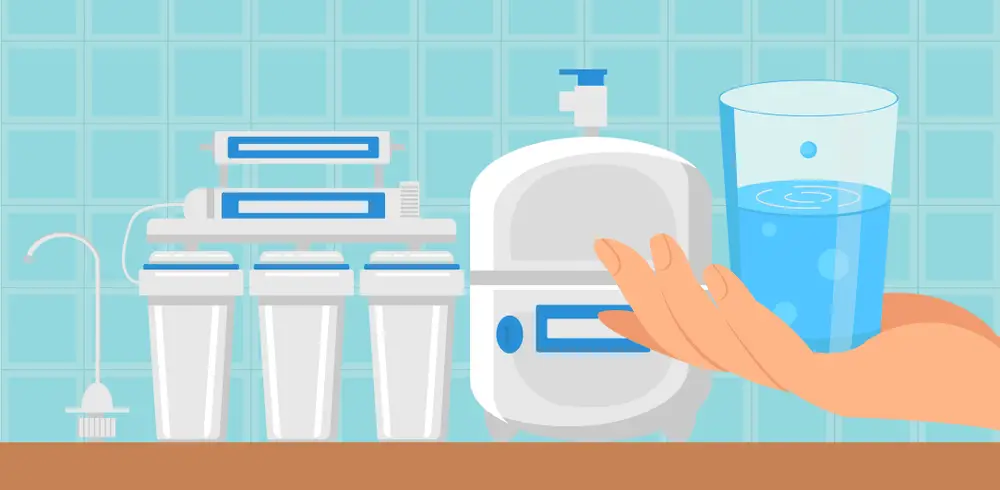We use water to do our cleaning, cooking, and drinking; it is unimaginable to live a life without water. Water is a major need in human life, but what if what we think is sustaining our life is the one that is poisoning us?
To disinfect water for drinking, most water companies use chlorine, which ends up being a concern. Therefore, we need to dechlorinate water before using it.
One can use carbon filters and reverse osmosis units to remove chlorine and chloramines from water among other methods. Also used are dechlorinating products, and ascorbic acids as well as treating with Campden tablets.
Most water companies use these agents because they have realized how dangerous untreated and raw water is, so they have begun making use of some agents to clean and disinfect the water. There are two most commonly and popularly used disinfection agents namely, chloramines and chlorine.
Let us explore how you can easily remove these agents from your water at home.
Also Read: 9 Best Kitchen Helper Stools and Towers: Safe for Toddlers
How to Remove Chloramines from Water
Chloramine is formed when water companies add a mixture of 20% ammonia and chlorine to a water supply. Most water companies have changed from chlorine to Chloramine since Chloramine is a bit stable and doesn’t evaporate like chlorine, although it’s a weaker disinfectant.
More to that chlorine makes disinfection byproducts called trihalomethanes (THMs) that are volatile organic chemicals (VOCs), which are highly carcinogenic. I will discuss three different methods of removing Chloramine from the water below:
1. Using Dechlorinating
Products
The least expensive and easiest way is by using chemical dechlorinating products. However, you should choose one carefully since all dechlorinators are not the same. Read the label of the product carefully, if a product states it removes chloramines and chlorine but doesn’t mention ammonia, beware.
Such products have a design that breaks the Chloramine bond, hence separating ammonia from chlorine then the chlorine gets eliminated; however, the toxic ammonia that is released is left in the water.
2. Using a Reverse Osmosis Unit
To remove chloramines easily, install and filter water through a reverse osmosis unit. however, ensure its quality model with a design that can remove chloramines, ammonia, and chlorine
3. Using Carbon Type Filter or Faucet
A simple carbon-type filter or faucet placed under the countertop can be used. However the unit must have high-quality carbon, and the water must be allowed enough contact time for the process to be completely effective.
Filter cartridges should be replaced often since Chloramine exhausts carbon faster than chlorine. However, it is advisable to invest in a tap water filter that has an indicator that informs you of the changing time of your cartridge
Eliminating Chloramine Using Chemicals
If you decide you want to dechlorinate the water you use in your facility, you can use chemicals such as Campden tablets. The easiest way of disposing of chloramines is by treating water with Campden tablets.
The tablets contain potassium metabisulfite 695mg, which is at times called “metabite.” This chemical is known to reduce Chloramine to chloride and ammonium ions.
The required dosage is, to take twice the level of Chloramine in your water and add the level of chlorine then divide it by six. And you will get the exact number of tablets needed to treat 20 gallons of water. However, not all the Campden tablets weigh 695mg neither are they all potassium metabisulfite; others are sodium
metabisulfite.
Consider weighing the Campden tablets, if no lb balance is available, weigh many tablets on a reloading scale or kitchen scale and divide by the quantity of the tablets.
If you are not sure the tablets are sodium salt or potassium, ask the supplier to check from the wholesaler or be presumptuous that they are potassium, if your guess is wrong then you will add 17% bisulfate more than required.
Also Read: Portable Sinks with Hot Water: Best Sink Units for Outdoors
How to Remove Chlorine from Water
Living in an area that has water that contains strong chlorine presence, most people always ask how to remove chlorine from their water after it’s treated through the municipal and has reached our homes and businesses; the right filter should give you pure, safe, and odorless water. To have water that is free from chlorine, the granular activated carbon filter is highly recommended.
One of the ways of achieving this is to use a granular activated carbon filter. The filter is made from organic raw materials like coal wood, and coconut shells, and the carbon is activated by heating which increases the surface area of the filter. The PUREPLUS 5 Micron 10″ x 4.5″ is one of the best filters.

The big surface area, combined with the natural porous properties of carbon, allows it to trap and absorb all-natural organic compounds, synthetic organic chemicals, tastes, and odors from the water that goes through.
Another way of removing chlorine from water is through a 10-micron filter known as a carbon block within the point-of-use system that has the same approach used by the granular activated carbon filter. In my experience, this is the best carbon block due to its effectiveness and use by many. They can also remove fluoride from home water is more time is spent doing the filtering.
However, these filters have a large surface area enabling it to trap a bigger number of contaminants. The active carbon of this cartridge filter can aid in trapping chemicals like chlorine.
Easily Dechlorinate Water Naturally at Home
The easiest and most convenient way of removing chlorine naturally at home is by boiling. All that you require is a clean and safe pot that can be used on the stovetop.
- Fill the pot with water halfway; don’t add any other thing to the water, for you will use it for drinking.
- Allow the water to come to a rolling boil and let it stay there for twenty minutes. Monitor it well and make sure it will not burn your pot or boil over.
- Allow the water to sit and cool to room temperature or transfer it to some other container before drinking it
- Boiling the water removes chlorine, Chloramine, and other contaminants like bacteria.
- Be informed that boiling cooking water is sufficient to remove chlorine, and also certain ingredients will neutralize chlorine and Chloramine while cooking
Dechlorination of Water Using Chemicals
Several chemical compounds are used in removing chlorine from water. A few of them are ascorbic acids, commonly known as vitamin C. They are safer and also edible. Read more about the uses of ascorbic acids and their benefits.

Other options include; sodium sulfite, sodium bisulfate, or sodium thiosulfate, the final by-products vary, sometimes the dechlorinated water is discharged into streams, and for instance, environmental regulations may take effect due to consequences such as reduced dissolved oxygen to the receiving stream, which is known as oxygen scavenging.
If you are purifying water for applications such as fish tanks, make sure your drinking water is not treated with chloramines, if it is you may have to use other chemicals for neutralization. However, if it has, getting rid of the Chloramine is a good idea, especially for tap water.
Also Read: Best stainless steel Kitchen sinks that don’t scratch: Resistant
How Chloramines and Chlorine Contaminate Tap Water
Many water treatment companies have stopped the use of chlorine as a disinfectant for drinking water. Dissolved organic matter reacts with chlorine in the water to produce by-products that are feared to cause health problems in humans, as well as various forms of cancer.
Various water treatment plants are now using disinfectants called chloramines, a combination of ammonia and chlorine; however, the use of Chloramine has increased lead in drinking water, this is because chloramines make lead to percolate from fixtures, solder, and pipes. This lead has a potential effect on blood lead levels.
Differences between Chloramine and Chlorine
Chloramine is the combination of chlorine and a small amount of ammonia. Chlorine is used commonly since it is safe, effective, and quick and it is also a cheap method of disinfecting water. Chlorine acts quicker and is used up faster due to its reaction with contaminants that are in the water.
- Chlorine is a more effective disinfectant than Chloramine. The World Health Organization has recorded that monochloramine is 100,000 and 2000 times more effective than free chlorine for the inactivation of rotaviruses and E.coli.
- Distilling, boiling, or standing uncovered cannot remove Chloramine
- Chloramines’ disinfection byproducts are more toxic than chlorine`s for example, iodoacids.
- Chloramine disinfection byproducts and vapors accumulate in indoors and the air and can concentrate in enclosed areas like kitchens, shower stalls, small bathrooms, or apartments.
- Chloramine fumes can cause congestion in an individual and lead to sinus sneezing, choking, coughing, shortness of breath, wheezing, and asthma
- A carbon filter harmonized with a reverse osmosis filter is necessary for the removal of Chloramine.
- No engineer of filtration systems can guarantee total removal of Chloramine even by using any comprehensive filtration system; however, chlorine can be removed easily with inexpensive carbon filtration.
- For high-flow utilization of water like bathing and showering, it is necessary to have the entire house filtration system to remove ammonia and Chloramine effectively.
- Rubber corrosion can be caused by Chloramine to rubber plumbing parts like rubber casings and toilet flappers
- Digestive disorders can be caused by Chloramine
- Digestive mucosa is damaged by Chloramine
Other Notable Differences
| Property | Chloramine | Chlorine | |
| Dissipation | Does not dissipate easily | Dissipates easily | |
| Removal Difficulty | less difficult to remove | more difficult to remove | |
| Filtration Cost | Filtration is expensive | Filtration of inexpensive | |
| Effectiveness | Less effective in killing pathogens | More effective | |
| Duration in water | Lasts longer in the distribution of the water system | Does not last longer than chloramine. |
Effects
of Exposure to Chloramines and Chlorine
It is important to remove chlorine and chloramines from your water since they pose severe health risks. According to recent studies, inhalation of exposure to chlorine is the most harmful.
Exposure to chlorine can cause symptoms such as blurred vision, blisters, redness on the skin in case there is exposure to chlorine gas, chest tightness, coughing, watery eyes, and many more.
Chloramine also poses some health threats especially to the skin if it’s exposed to Chloramine. These include; red burning skin and rashes, intense itching, chapping, flaking, dry, cracking skin, bleeding, dry, itchy scalp, and dandruff.
Other health risks include; Respiratory symptoms such as nasal congestion and sinus, wheezing and coughing, swollen throat, dry throat, difficulty swallowing, and shortness of breath. Therefore follow the guidelines in the write-up above to remove chloramine and chlorine from your water.
Also Read: Best Bathroom Sink Materials and Pros & Cons of each
Conclusion
There are various kinds of dangerous wastes being thrown into water bodies, as well as pollution. This polluted water is what we use to drink, wash our dishes, wash our clothes, and clean our bodies. We need to filter such water.
While there are various ways of purifying water, some are specific. If there are chlorine and chloramine that need to be dechlorinated, the specialized methods discussed above can be used.

I am a homeowner excited by various innovative products and solutions that make life better. I am happy to share such ideas and reviews of home and related products.
